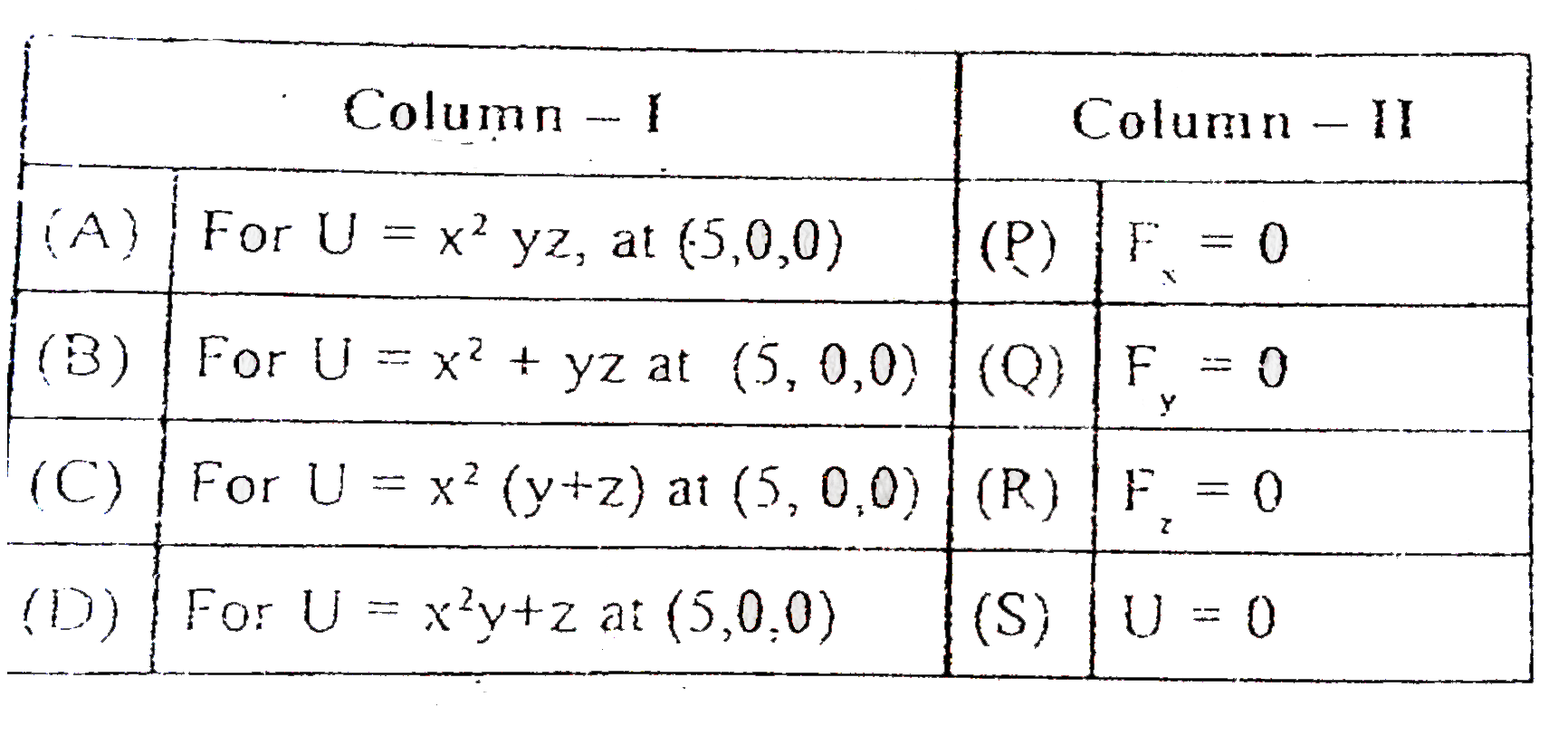For conservative force field, →F=−∂U∂xˆi−∂Udyˆj−∂U∂zˆk where F→ Maginitude of Force. U→ Potential energy and ∂U∂x= Differentiation of U w.r.t. x keeping y and z constant and so on.

Choose incorrect matching :−
(A)→(P,Q,R,S)
(B)→(Q,R)
(C)→(P,S)
(D)→(P,R,S)
The correct Answer is:D
For (A) : →F=−2xyzˆi−x2zˆj−x2yˆk⇒Fx=0,
Fy=0,Fz=0,U=0
For(B) :→F=−2xˆi−zˆj−yˆk⇒Fx≠0,Fy=0,Fz=0,U≠0
For (C) : →F=−2x(y+z)ˆi−x2ˆj−x2ˆk⇒Fx=0,Fy≠0,Fz≠0,U=0
For (D) : →F=−2xyˆi−x2ˆj−ˆk⇒Fx=0,Fy≠0,Fz≠0,U=0
Topper's Solved these Questions
Similar Questions
The position vector of a particle is given by →r=kcosωˆi+ksinωˆj=xˆi+yˆj, where k and ω are constants and t time. Find the angle between the position vector and the velocity vector. Also determine the trajectory of the particle.
View SolutionIf electric field is
(a) →E=2axyˆi+a(x2−y2)ˆj
(b) →E=ayˆi+(ax+bz)ˆj+byˆk)
Find potential.View Solution
Knowledge Check
- Question 1 - Select One
The torque of a force →F=−2ˆi+2ˆj+3ˆk acting on a point →r=ˆi−2ˆj+ˆk about origin will be
A8ˆi+5ˆj+2ˆkB−8ˆi−5ˆj−2ˆkC8ˆi−5ˆj+2ˆkD−8ˆi+5ˆj−2ˆk - Question 2 - Select One
Find the potential V of an electrostatic field →E=a(yˆi+xˆj), where a is a constant.
Aaxy+CB−axy+CCaxyD−axy - Question 3 - Select One
Let→V=vxˆi+vyˆj+vzˆk, then ∫t2t1Vy represents: (for the duration t1→t2)
ADistance travelled along y-axisBDisplacement along y-axisCTotal displacement - displacement along y-axisDTotal distance travelled - distance travels along y-axis
A body constrainedto move along the z-axis of a co-ordinate system is subjected to a constant force →F given by →F=−ˆi+2ˆj+3ˆk newton where ˆi,ˆjand ˆk represent unit vectors along x-,y-,and z-axes of the system, respectively.Calculate the work done by this force in displacing the body through a distance of 4malong the z-axis.
View SolutionElectric dipole of moment →p=pˆi is kept at a point (x, y) in an electric field →E=4xy2ˆi+4x2yˆj. Find the magnitude of force acting on the dipole.
View SolutionThe torque of a force →F=−2ˆi+2ˆj+3ˆk acting on a point →r=ˆi−2ˆj+ˆk about origin will be
View SolutionElectric field is given by →E=(8ˆi+4ˆj+3ˆk)NC−1. Electric flux through Y-Z plane X-Z plane are in ratio
View SolutionAn object is acted upon by the forces →F1=4ˆiN and →F2=(ˆi−ˆj)N. If the displacement of the object is D=(ˆi+6ˆj−ˆk)m, the kinetic energy of the object
View Solution

